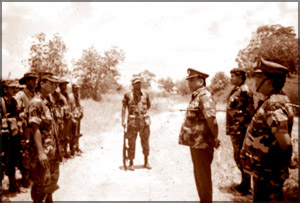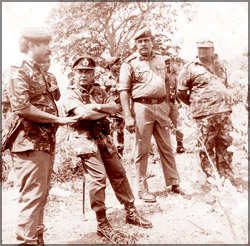Legacy of Vadamarachchi - 20 years on
Today marks the 20th anniversary of the Vadamarachchi
battle, one of the most decisive battles in the history of the
North-East conflict:
Ranil Wijayapala
HEROIC BATTLE: The Military option has never been the choice of any
Government to find a solution for the North East conflict. But a
militaristic approach to the North East conflict has been used by
consecutive Governments to bring pressure on the Tiger outfit to shun
violence and to enter the path of peace.
Vadamarachchi battle, the pride of all battles fought by the Security
Forces was one of the exemplary battles fought by our
|

Lt. General Denzil Kobbekaduwa before the operation
|
heroic soldiers in
the calibre of Denzil Kobbekaduwa and Wijeya Wimalaratna who were
posthumously promoted to the ranks of Lt. General and Major General
following their untimely deaths in 1991.
Two decades have already passed since this exemplary battle fought in
Vadamarachchi in Jaffna in 1987 to defeat Tiger leader Velupillai
Prabhakaran at his home town Velvetithurai and bring him to his knees.
The battle still echoes in the hearts and minds of valiant Security
Forces personnel.
According to late Lalith Athulathmudali, then Minister in charge of
National Security, as reported in the book 'Vadamarachchi Vimukthi
Meheyuma and Uthure Satan' written by Captain Thilak Senanayaka the
battle fought in Vadamarachchi was not meant to provide a lasting
solution to the North East conflict by defeating the Tiger outfit
militarily.
The intention of the battle, as explained by Minister Athulathmudali
to Brigadier Kobbekaduwa and Colonel Wimalaratna at Palaly Army camp as
the battle was in progress, was to deal a blow to the brain and heart of
the Tiger outfit and expose the real picture of the organisation to the
Tamil civilians in the bid to liberate them from the Tiger grip.
According to him, the Government led by President J.R. Jayawardene
was of the opinion that a political solution was a must to solve the
North East conflict and militaristic approach to the issue was taken
only to clear the path towards that end to put a stop to violent
activities of the Tiger outfit.
However, the objective of the Security Forces engaged in the
Vadamarachchi operation could not be reached, though they were capable
of achieving that honourable task with the leadership of then Brigadier
Kobbekaduwa and Colonel Wimalaratna, due to pressures from regional
powers.
Not only Sri Lanka and our giant neighbour India, but also the entire
world now sees the repercussions of those external pressures. If the
Forces were allowed to achieve the real task, as explained by late
Athulathmudali to expose the real picture of the LTTE organisation, the
situation of Sri Lanka would have been much better today.
Denzil Kobbekaduwa and Vijeya Wimalaratna would have been still alive
today to serve this country if they were allowed to achieve the final
goal of their battle.
Even Defence Secretary Gotabhaya Rajapaksa who played a key role in
the Vadamarachchi operation in 1987 along with
|

Talking to soldiers before the operation
|
Colonel Wimalaratna
commanding 'Gajaba' men would not have had to toil much labour today to
defeat terrorism in the North - East.
Many of the key personnel involved in the Vadamarachchi operation,
the biggest military operation undertaken by the Security Forces after
the North East conflict reached a new dimension in 1983, are not alive
today to recall their brave acts.
But war literature gives us a clear impression about how our war
heroes bravely fought the battle to defeat the Tiger outfit to free the
Tamils from the myth of achieving the Tamil homeland concept, forcibly
imposed on them by Tiger leader Prabhakaran.
The dawn of May 26, 1987 marked the day of launching the 'Operation
Liberation' famously known as the Vadamarachchi operation, the biggest
operation launched jointly by the Armed Forces in Sri Lanka.
'Operation Liberation' was conducted to wrest control of the
Vadamarachchi area in the Jaffna peninsula, and was aimed at forcing the
LTTE to enter negotiations.
This was the first time in military history of Sri Lanka that two
brigades were launched in an offensive operation. These two brigades,
under the command of late Lt. Gen. Kobbekaduwa and Maj. Gen. Wijaya
Wimalarathne were able to complete the capture of the Vadamarachchi area
within five days. About 8,000 troops from the Gemunu Watch and Gajaba
Regiments were involved in the Vadamarachchi operation.
As mentioned in the book The Broken Palmyra on May 18, a diversionary
column of troops marched Northwest from Elephant Pass.
Around 20 May, diversionary actions were also launched in Navatkuli
and Palaly. Colonel Radha, the LTTE commander for the Mannar district
was killed in action at Navatkuli.
Radha, a mild-looking ex-bank officer, was noted for his daring. The
Army made a rapid advance towards Atchuvely through Iddaikkadu from
Palaly. When the advance commenced, the LTTE is said to have had 15 men
in the area.
More men were then ferried in by vehicles and the advance was
fiercely resisted. This thrust too turned out to be diversionary as the
Army withdrew on the 23rd.
Throughout the whole operation, the Forces enjoyed unchallenged
freedom of the air. According to sources probing and diversionary action
for the operation to recapture the peninsula had begun by May 18 and the
operation was planned and executed with commendable efficiency.
The capacity to gather and analyze intelligence had been strengthened
with foreign, and particularly Israeli, help to an admirable degree.
The opportune moment to commence the operation came on May 26 when
the Security Forces learnt from intelligence reports that Tiger leader
Prabhakaran was in Valvettithurai.
According to the book written by Captain Senanayaka, it was a battle
fought by soldiers with greater enthusiasm.
Some war veterans observed this operation as an operation conducted
by the Army displaying their humanity towards the
|

Kobbekaduwa , Wimalaratna and other Officers
|
Tamil people turning the operation into a 'hearts and minds
campaign' to win over the Tamil people.
The Army fielded seven Infantry Battalions, two squadrons of Armoured
cars, two Regiments of Artillery, two Squadrons of Field Engineers and
one Commando Regiment to complete the mission.
The Sri Lanka Air Force allocated a large fleet of aircraft six
Siai-Machetti SF-260s for Fighter Ground Attack operations, and five
helicopters were deployed as troop carriers.
One Avro, two Chinese Y-12s and one De Havilland Heron were
configured by the SLAF as improvised bombers although none of these
aircraft was designed for such duties.
As a result of this Operation, the entire area of Vadamarachchi was
brought under the control of the Security Forces on June 3.
This was a severe blow to the LTTE as Vadamaarachchi is the
birthplace of the Tiger leader, V. Prabhakaran, and also most of the
senior cadres of the LTTE are natives of Velvettithurai, the main
township of Vadamaarachchi.
Consequent to this operation, the Army was entrusted with the
administration of a large number of civilians.
Before the Security Forces commenced the next phase of the operation,
aimed at gaining control of the entire Jaffna peninsula, a convoy of
fishing vessels from India with relief supplies arrived on June 3 and
then the Indian airdrop of 25 tons of relief supplies on Jaffna the
following day marked the end of the operation.
The Peace Accord with India was signed on the July 29, 1987 and the
Indian Peace Keeping Force, (IPKF), began arriving, thus marking a new
dimension in the separatist war in Sri Lanka.
But India could understand the true picture of the Tiger leader only
when Indian Prime Minister Rajiv Gandhi was assassinated by a LTTE
suicide cadre in May 1991. |

